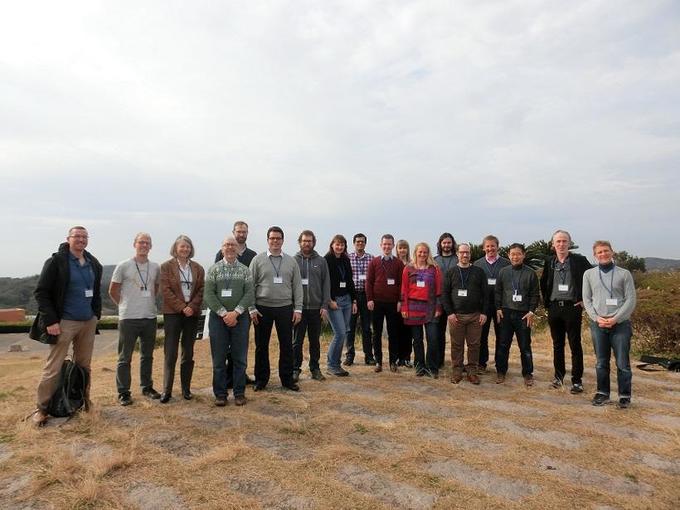NO.142 Web Molecular Graphics: Emerging Technologies & Standards
December 3 - 6, 2018 (Check-in: December 2, 2018 )
Organizers
- Prof. Seán I. O’Donoghue
- CSIRO Data61, Australia
- Prof. Masakazu Sekijima
- Tokyo Institute of Technology, Japan
- Dr. Marc Baaden
- Laboratoire de Biochimie Théorique, France

Overview
Description of the Meeting
Background
Molecular Graphics (MG) unites computer graphics and software engineering to provide modelling, simulation, and visualization essential to a wide range of scientific and commercial research, from the life sciences to chemistry and material science. MG is a mature discipline with a wealth of methods and tools, originally focused on stand-alone software. Recently, however, rapid new developments are exploring the use of MG within web browsers, opening exciting new possibilities, such as large-scale collaboration. At the same time, advances in experimental methods now make available molecular structures of unprecedented size and complexity, giving new insights into the molecular machinery of life, but also requiring much increased computational performance, and sometimes the use of new display technologies (e.g., distributed and multiscale displays).
In response, the first Shonan seminar on Web-based Molecular Graphics was held in 2016. This exciting meeting bought together, for the first time, key international players in this newly emerging field. The meeting featured broad-ranging discussions that identified key common issues and create new collaborations; this has had significant impact in our field, helping consolidate ongoing efforts, and resulting in several publications.
We now propose a second, more focused meeting to explore four specific topic areas: (1) Standards (de facto and emerging); (2) Big molecular data; (3) Emerging technologies (e.g., VR/AR, WebVR, HMDs); and (4) Community building. In the 2016 meeting, these issues that were identified as high-priority next steps for our community. Since then, each of these areas has been impacted by rapid technological advances. Thus, for our next proposed meeting, we have selected invitees with expertise matching to these topics, and thereby spanning computer science, molecular graphics, and bioinformatics. The focus will be on how advances in these topics can be leveraged to create the next generation of molecular graphics methods and tools, which, in turn, will give scientists the power to explore the molecular realm in unprecedented detail and clarity.
Specific aims of the seminar
Standards (de facto and emerging). This will be a core topic for discussion, focusing on clarifying standards specifically related to (1) web-based graphics (e.g., WebGL, OpenGL, three.js), (2)molecular graphics (e.g., PDBx , MMTF ), (3) related biomolecular information (e.g., 2D images or 3D envelopes from microscopy experiments), (4) a common query grammar for specifying parts of molecular structures (e.g., MolQL), and (5) improving visualization conventions for web molecular graphics (e.g., CPK).
Big Molecular Data. Increasing more data on molecular dynamics are available, and for increasingly larger molecular systems (especially due to advances in CryoEM). Managing these unprecedented amounts of data will require new approaches in the data structure, compression, transport, and storage, as well as new client-server paradigms and on-demand, multi-scale display methods.
Emerging Technologies (VR/AR, WebVR, HMDs) . Molecular graphics have always been an area where new graphic technologies were tested. Today, new display technologies such as Virtual Reality (VR) and Augmented Reality (AR) are being developed within the browser (e.g. WebVR). These technologies are very promising for exploring large spatial structures. Although the use of VR and AR in molecular graphics is not new, their use in a web context provides exciting new possibilities that we plan to explore, along with a consideration of user-experience design perspectives.
Community Building. Perhaps most importantly we will focus on defining and initiating new community practises that will facilitate global, pre-competitive collaborations that will help accelerate the development of web molecular graphics. We will do this by defining our needs, primarily focusing on creating new strategies to enable collaborative work on the development of molecular graphics. Increasingly, the power of the web is being leveraged to enable collaborative development; but standards and best-practises are still evolving. Thus, we will invite key players who have been involved in successful, online collaborative development (e.g., Khronos Group, PDB, SBML) – some outside of molecular graphics – so our field can benefit from their experience. The result will be a clear set of new, very interesting challenges for computer science, and eventually, many benefits to users of molecular graphics across many scientific fields.
Publication Plan
We plan to publish several focused papers on the discussion topics in venues that will best reach specific target communities. A core focus will be greatly extending existing guidance documentation and accompanying illustrations at the online repository created in GitHub during the 2016 meeting. This repository will host ongoing conversations, helping to orchestrate the growth and outreach of the web molecular graphics community.
